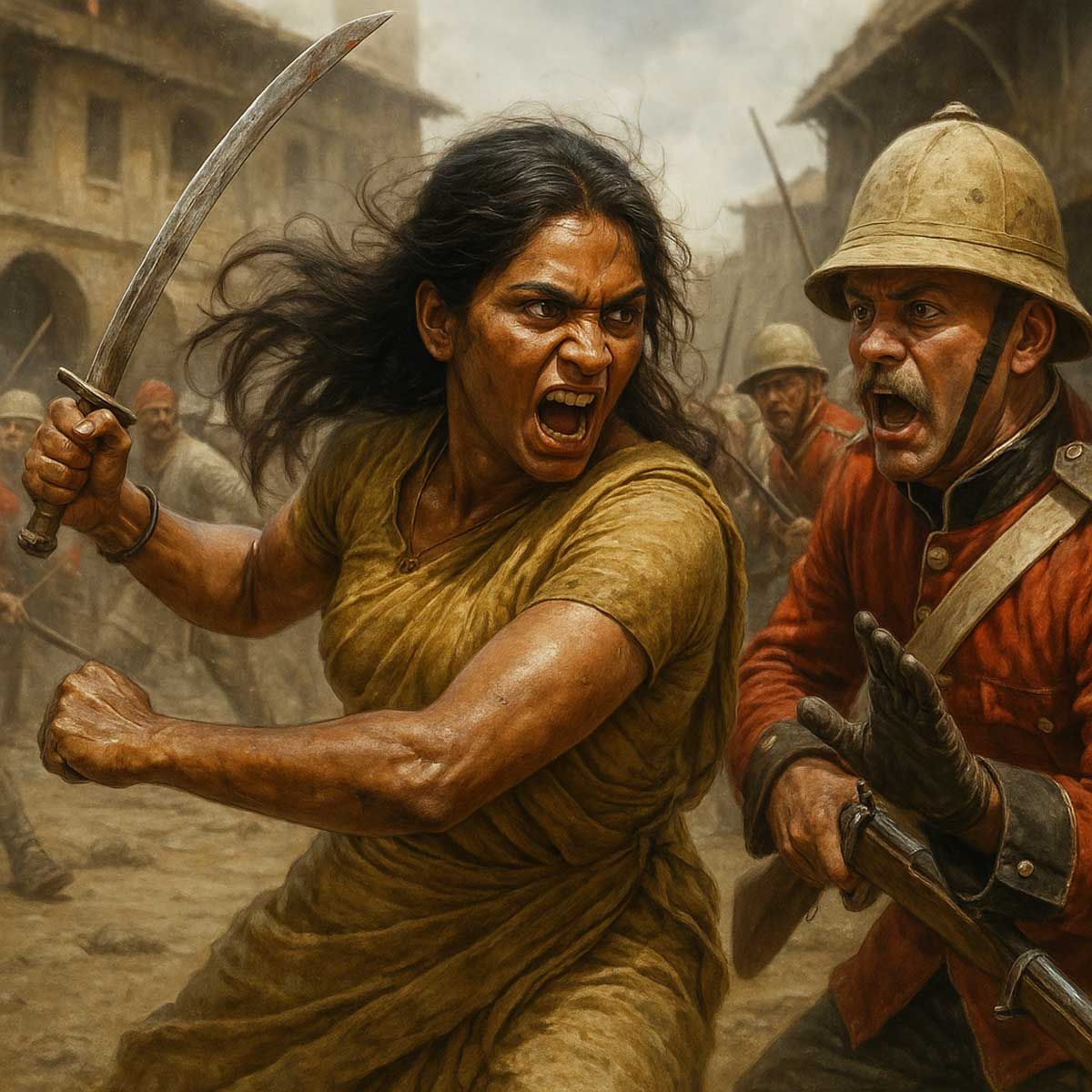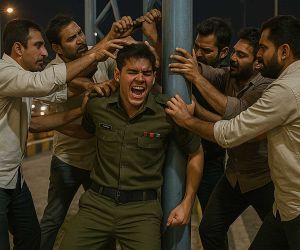MORE COVERAGE
Twitter Coverage
Satyaagrah
Written on
Satyaagrah
Written on
Satyaagrah
Written on
Satyaagrah
Written on
Satyaagrah
Written on
JOIN SATYAAGRAH SOCIAL MEDIA
"घर आजा परदेसी": Harsimrat Randhawa, a 21-year-old Indian student killed by a stray bullet in a gangland-style shooting in Hamilton, Ontario, on April 16, one of six Indian student deaths in Canada in a year, sparking urgent calls for safety and justice

On a quiet Wednesday evening, April 16, 2025, a sudden burst of violence shattered the life of Harsimrat Kaur Randhawa, a 21-year-old Indian student at Mohawk College in Hamilton, Ontario. While standing at a bus stop, Harsimrat was struck by a stray bullet, a heartbreaking loss that has left her family, friends, and the Indian community in Canada reeling. Her untimely death highlights the devastating impact of senseless violence, touching hearts far beyond the borders of Hamilton.
|
Wednesday, April 16, 2025: The Incident
At around 7:30 PM, Hamilton Police were alerted to a shooting near Upper James Street and South Bend Road in Hamilton, Ontario. The incident was described as a "gangland-style" shooting involving two vehicles—a black Mercedes SUV and a white sedan. According to police, a passenger in the black Mercedes SUV fired multiple shots at the white sedan, turning a busy intersection into a dangerous scene. In the chaos, a stray bullet struck Harsimrat Randhawa, who was waiting at a nearby bus stop on her way to her part-time job. The bullet hit her chest, causing a fatal injury. Despite being rushed to a hospital, she could not be saved. The gunfire also damaged a nearby home on Allenby Avenue, where bullets shattered a rear window while residents watched television. Thankfully, no one inside the home was hurt. Both vehicles sped away after the shooting, leaving police to piece together the events.
Harsimrat, originally from Dhunda village in Punjab’s Tarn Taran district, had come to Canada two years ago to study at Mohawk College, pursuing a career in the medical field. Known for her dedication and ambition, she was simply going about her daily routine when tragedy struck. Hamilton Police confirmed that the shooting was a targeted attack, but Harsimrat was an "innocent bystander", caught in a conflict that had nothing to do with her. Authorities are now investigating the incident as a homicide, urging anyone with dashcam or security footage from 7:15 PM to 7:45 PM near the area to come forward.
Thursday, April 17, 2025: Initial Reports and Community Response
By Thursday morning, the heartbreaking news of Harsimrat’s death began to spread across Hamilton and beyond. Hamilton Police released her name and a photograph, hoping to gather more information from the public. They reiterated that Harsimrat was an "innocent bystander", caught in the crossfire of a violent exchange. The announcement sent shockwaves through Mohawk College, where Harsimrat was a valued student. The college issued a heartfelt statement:
“Our thoughts are with her family and friends at this difficult time. As a member of the Mohawk College community, we know this loss is being felt by many, and we will do everything we can to support Harsimrat’s friends, family, and the broader college community.”
The statement reflected the deep sense of loss felt by students and faculty, who remembered Harsimrat as a kind and driven individual.
In Dhunda village, thousands of miles away, Harsimrat’s family received the devastating news through local authorities. Her relative, Sukhvinder, spoke of her as a bright young woman with a younger brother and big dreams. She was the pride of her family, working hard in Canada to build a future in healthcare. The family was overwhelmed with grief, struggling to process the sudden loss while facing the daunting task of arranging to bring her body back to India. The tragedy left the small village in mourning, with neighbors and relatives gathering to support the family.
Friday, April 18, 2025: Official Condolences and Family’s Plea
On Friday, the Consulate General of India in Toronto issued a public statement on X, expressing their sorrow and commitment to support Harsimrat’s family: “We are deeply saddened by the tragic death of Indian student Harsimrat Randhawa in Hamilton, Ontario. As per local police, she was an innocent victim, fatally struck by a stray bullet during a shooting incident involving two vehicles. A homicide investigation is currently underway. We are in close contact with her family and are extending all necessary assistance.” The consulate’s words offered a glimmer of hope to the family, who were navigating the complexities of international procedures during their grief.
Back in Punjab, Harsimrat’s family made a heartfelt plea to the Indian government and Punjab state authorities for help in repatriating her body. They explained that the shooting resulted from a clash between two groups, aligning with police reports of a targeted attack.
|
Saturday, April 19, 2025: Growing Concerns and Investigation Updates
By Saturday, the heartbreaking news of Harsimrat Kaur Randhawa’s death had spread widely, sparking an outcry on social media platforms, especially on X (formerly Twitter). Voices from across the globe began to echo a shared sentiment of grief and alarm. One user pointed out that her death was reportedly the “fourth Indian fatality in Canada in four months,” a claim that, while not independently verified, reflects the increasing concern within the Indian diaspora about the growing threat of violence in Canada. This particular statement resonated deeply, creating a sense of urgency and vulnerability among international students and their families back home.
Meanwhile, Hamilton Police intensified their efforts to identify those responsible. Investigators shared fresh details about the vehicles involved in the shooting and urged the public to come forward with any information. They closely examined available video footage, which confirmed that the incident was a “gangland-style” shooting, reinforcing suspicions of possible links to organized crime networks. Although the authorities had not named any suspects yet, the nature of the investigation made it clear they were pursuing the case as a serious criminal offense.
Throughout this time, Mohawk College continued to provide support to Harsimrat’s family and classmates. In a statement shared by CBC News, the college emphasized that it was standing by the grieving community. The college reiterated its role as a source of strength and comfort during this emotionally heavy period. The messages coming from the institution highlighted the deep loss felt across the student body, reminding everyone of how deeply interconnected such tragedies become in academic spaces far from home.
The devastating death of Harsimrat Randhawa is more than a local tragedy. It serves as a painful reminder of how easily innocent lives can be lost due to gun violence, even in places where such acts are not a common occurrence. The fact that police described the shooting as “gangland-style” brings to light serious concerns about organized crime or gang activity in Hamilton. It raises the question: how secure are public spaces when innocent bystanders like Harsimrat can be caught in crossfire?
This tragic event did not just impact one family or college—it shook the foundation of confidence among international students, particularly those from India. These students travel thousands of miles in search of knowledge, careers, and better futures, often stepping into unknown societies without a full grasp of local dynamics.
While the Consulate General of India in Toronto responded promptly and is actively helping the family, the bigger issue still remains—how prepared are systems to handle such tragedies? Families dealing with the sudden loss of a child abroad must go through a painful maze of paperwork, expenses, and emotional trauma. In this case, the family’s request for support from the Indian and Punjab governments made clear how overwhelming and exhausting this journey can be.
The death of Harsimrat Kaur Randhawa on April 16, 2025, has become a defining moment for many. From the terrifying moment she was struck by a stray bullet while waiting at a bus stop, to the communal grief felt from Dhunda village in Punjab to Hamilton, Ontario, the ripple effects of this tragedy are wide and profound. As the Hamilton Police move forward with their homicide investigation, the hope remains that justice will be served swiftly and surely. But beyond that, her story calls for action—against gun violence, for the protection of international students, and for humanity to step up in moments of crisis. Her memory now stands as a reminder of just how fragile life can be, and how important it is that no other family has to suffer this kind of irreversible loss.
|
Reported Deaths of Indian Students in Canada (April 19, 2024 – April 19, 2025)
The past year has witnessed a deeply disturbing trend—at least six Indian students or recent graduates have lost their lives in Canada between April 19, 2024, and April 19, 2025. Their names now stand as painful reminders of the harsh realities many young Indians face while pursuing education abroad. These incidents include both targeted killings and tragic accidents, leaving behind unanswered questions, grieving families, and a diaspora community on edge.
Yuvraj Goyal (Date: June 7, 2024)
Details: Yuvraj Goyal, a 28-year-old Indian-origin man from Ludhiana, Punjab, was shot dead in Surrey, British Columbia. Goyal arrived in Canada in 2019 on a student visa and had recently obtained permanent resident status. The incident was reported as a targeted killing, with four suspects arrested and charged with first-degree murder.Chirag Antil (Date: April 2024)
Details: Chirag Antil, a 24-year-old Indian student, was shot dead inside his car in South Vancouver, British Columbia. The incident occurred earlier in April 2024, and his parents appealed to Indian authorities for assistance in repatriating his body. The circumstances suggested a targeted attack, though specific details on the investigation were not widely reported.Gurasis Singh (Date: December 1, 2024)
Details: Gurasis Singh, a 22-year-old postgraduate student from Ludhiana, Punjab, was stabbed to death by his roommate, Crossley Hunter, in a rental house on Queen Street in Sarnia, Ontario. Singh had arrived in Canada four months prior to pursue higher studies. The altercation occurred in the kitchen, and Hunter was charged with second-degree murder.Rittika Rajput (Date: December 2024)
Details: Rittika Rajput, a 22-year-old student from Punjab, died in British Columbia after a tree fell on her during a late-night bonfire with friends. She was declared dead at the scene. The police are investigating the incident, which was initially reported as an accident.Harshandeep Singh (Date: December 6, 2024)
Details: Harshandeep Singh, a 20-year-old Indian-origin man working as a security guard while studying, was shot dead by a gang in Edmonton, Alberta. The Edmonton Police Service arrested two individuals, charging them with first-degree murder. The incident was described as a targeted gang-related attack.Harsimrat Kaur Randhawa (Date: April 16, 2025)
Details: Harsimrat Kaur Randhawa, a 21-year-old student at Mohawk College in Hamilton, Ontario, was killed by a stray bullet while waiting at a bus stop. The shooting occurred during a "gangland-style" exchange of gunfire between two vehicles on Upper James Street. Hamilton Police confirmed she was an innocent bystander, and the investigation remains ongoing with no suspects named.
The confirmed deaths show a serious and deeply emotional reality. At least six young Indian lives were lost, all of them either students or recent graduates, and most were victims of violence. Some of these cases—like those of Goyal, Antil, and Harshandeep Singh—were clearly linked to targeted killings or gang-related violence. Others, such as Rittika Rajput’s, were tragic accidents. Yet, all share one common thread: they were far from home, seeking a better future.
According to the Indian Ministry of External Affairs (MEA), between 2019 and July 2024, 172 Indian student deaths were recorded in Canada. Out of these, nine were due to violent attacks. The specific details of each case in the past year, however, remain scattered or incomplete in public databases. Furthermore, some deaths go unreported in mainstream media, especially those involving natural causes, suicides, or drug overdoses.
For example, a community member from Surrey, British Columbia, mentioned that 47 students had died from overdoses or suicides in the region's lower mainland in just two years. These figures point to a much bigger problem—many of these young lives are not publicly acknowledged, and their stories fade away without national attention or structural intervention.
Critical Analysis
The rise in Indian student deaths—whether from violence, accidents, or otherwise—paints a troubling picture. Canada hosted more than 427,000 Indian students in 2024, a number that continues to grow as families view Canada as a safe, high-quality destination for education. But these recent incidents challenge that perception.
The concentration of violent incidents in places like Ontario, British Columbia, and Alberta—especially in major urban centers—points toward possible links to gang activity, drug crime, or systemic vulnerabilities. The killings of Harsimrat Kaur Randhawa and Harshandeep Singh are both directly connected to gang-style shootings, suggesting a larger issue that affects even bystanders and unrelated individuals.
One of the most pressing concerns is the lack of central data collection. Immigration, Refugees and Citizenship Canada (IRCC) does not publish consolidated statistics on international student fatalities. This makes it harder for both governments and communities to understand the scale of the problem, and even harder to address it effectively.
Meanwhile, the Indian government has issued advisories, warned students to stay vigilant, and expressed concern over rising violence. But deeper systemic problems remain—including high tuition fees, exploitation by landlords or employers, and inadequate mental health support. Many students arrive full of dreams but quickly find themselves facing crushing financial burdens, social isolation, or even unsafe living conditions.
The confirmed deaths of Yuvraj Goyal, Chirag Antil, Gurasis Singh, Rittika Rajput, Harshandeep Singh, and Harsimrat Kaur Randhawa should not be seen as isolated tragedies. They are part of a bigger, more alarming pattern—one that deserves not only recognition but also serious action.
It’s time for both the Indian and Canadian governments to collaborate on safety protocols, establish emergency response systems, and create transparent databases of such incidents. Every student’s life matters, and every life lost is a future gone too soon.
 Support Us
Support Us
Satyagraha was born from the heart of our land, with an undying aim to unveil the true essence of Bharat. It seeks to illuminate the hidden tales of our valiant freedom fighters and the rich chronicles that haven't yet sung their complete melody in the mainstream.
While platforms like NDTV and 'The Wire' effortlessly garner funds under the banner of safeguarding democracy, we at Satyagraha walk a different path. Our strength and resonance come from you. In this journey to weave a stronger Bharat, every little contribution amplifies our voice. Let's come together, contribute as you can, and champion the true spirit of our nation.
 |  |  |
| ICICI Bank of Satyaagrah | Razorpay Bank of Satyaagrah | PayPal Bank of Satyaagrah - For International Payments |
If all above doesn't work, then try the LINK below:
Please share the article on other platforms
DISCLAIMER: The author is solely responsible for the views expressed in this article. The author carries the responsibility for citing and/or licensing of images utilized within the text. The website also frequently uses non-commercial images for representational purposes only in line with the article. We are not responsible for the authenticity of such images. If some images have a copyright issue, we request the person/entity to contact us at This email address is being protected from spambots. You need JavaScript enabled to view it. and we will take the necessary actions to resolve the issue.
Related Articles
- Amidst the backdrop of G20 Summit, PM Justin Trudeau's unexpected 36-hour delay in India has stirred controversy, from alleged technical snags to clandestine drug rumors and the media's enigmatic quietude, this incident leaves more questions than answers
- Hindu community living in a state of fear as half-a-dozen temples have been vandalised and robbed in the last two weeks amidst the ongoing truckers’ protest: Canada
- "Rising racism grips Ireland": a 6-year-old Indian-origin girl punched in the face and hit in her private parts in Waterford, a cab driver left bleeding, a chef robbed, an Amazon worker stabbed, a data scientist disfigured—5 brutal attacks in a month
- "He was never more sinister than when he was most polite": Canada government "Health Canada" funds 'Assisted Suicide' activity Book...for kids, launched Medical Assistance in Dying (MAID) in 2020 for slashing palliative care and other end-of-life costs
- Canada’s 2025 report exposes funding for Khalistani groups, recalls Trudeau’s Nijjar row and Hindu Sabha attack, as Modi and Carney try to revive strained India–Canada ties despite SFJ’s Surrey “embassy”
- 28-year-old Khalistani terrorist Arshdeep Dalla, an aide to Hardeep Singh Nijjar detained in Canada, linked to murders, extortion and terror modules in Punjab, his associates remain active as Indian extradition efforts face hurdles amid diplomatic tension
- "From Father to Son: A Troubling Legacy": In a sinister echo of the past, Canadian PM Trudeau openly endorses Khalistani elements against India, uncovering the dark history of Pierre Trudeau shielding notorious Kanishka bombing mastermind Talwinder Parmar
- Four Indian-origin seniors vanished on a road trip from Buffalo to a West Virginia temple, last seen at a Burger King in Erie—days later, their car was found crashed off a steep embankment near Big Wheeling Creek, all four tragically confirmed dead
- Mehul Prajapati, an Indian student in Canada debunks misinformation that he was paid $98,000, clarifies he was never employed at TD, nor was he fired; he faces bullying and threats with hate messages demanding he 'be careful' and 'go back to your country'
- Canada, post stirring a diplomatic tempest over unproven claims, now cites social media threats to realign its staff in India, emphasizing Vienna conventions, and urge India to ensure security for their diplomats, as they do for Indian officials in Canada
- Sikhs for Justice accused Russia of aiding India’s RA&W in killing Khalistani terrorist Nijjar; Russia denied claims, called SFJ’s $25K reward for tracking diplomats unacceptable, sought law enforcement action, and protection under Vienna Convention laws
- "Face the future, say 'bring it on'": NIA lists 43 top criminals, including Canada-based with Khalistani ties, as tensions rise, Trudeau implicates India in Nijjar's Canada murder; India promptly refutes, calling the accusation 'absurd and motivated'
- "Turbulence tests the strength of community bonds": Hindu temple in Canada faces vandalism by Khalistan supporters, spotlighting escalating tensions after Khalistani activist Hardeep Singh Nijjar's death, What's next for the Hindu community abroad
- "A one-man global protest": Trudeau fails in rallying allies against Modi Govt over Khalistani support; Five Eyes nations prioritize relations with India, dismissing his claims and continuing strategic partnerships, signaling 'move on' diplomatically
- "New India, NaMoIndia": Under PM Modi's resolute leadership, India stands firm in the face-off with Canada, leading to a comedic exit of 41 Canadian diplomats, India's new era of assertiveness clearly doesn't mesh with Canada's silly diplomatic approach

























